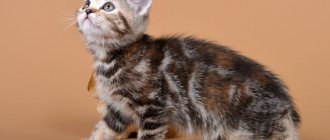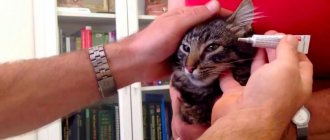What can you teach a cat
The commands that are taught to dogs can also be taught to cats, especially curious ones. She can learn to sit, lie down, give a paw, fetch a toy and do various tricks. You can teach your pet elements of a circus program: jumping through a hoop, walking on its hind legs, fetching a ball.
Of course, training cats is different from training dogs; these are different types of animals, and they need an individual approach.
Special training systems have been developed for cats and are used by people at home. With regular exercise, even a 2-month-old kitten will achieve positive results.
Special conditions must be created for training, then the result will be as effective as possible:
- Your four-legged friend must be in good health.
- It’s better if the cat ate a long time ago, then rewarding it with a treat works better.
- A good, playful mood between the owner and the cat - it is important that the pet enjoys the process.
- The lesson should not last long, no more than five minutes: cats quickly lose interest in training.
- Age also matters - you should not train small kittens, less than two months old or old kittens, most likely this will not bring the desired results.
How to teach a cat to give paw
“Give me your paw” is a simple command, every tailed animal can learn it. It looks cute and impressive. Teaching a cat to give paw is easy. You need to approach a sitting animal, put its paw in your hands and say, “Give me your paw.” When the ritual is over, you need to reward the kitten for a successfully completed command by treating it with a treat.
A reflex should be formed in the experimental subject’s brain, which should provoke the kitten to give its paw, based on pleasant memories.
If the cat independently reaches for a treat lying in the palm of your hand, then it is not necessary to take the cat’s paw in your hand. It is enough to say the name of the team when your pet tries to take the reward.
If the cat does not want to give his paw and is constantly distracted by more interesting things, it is better to postpone training and prepare him for training, based on the first point of the article.
Is it possible to teach a Scottish kitten to sit and stand?
You can teach a Scottish cat to obey the command to stand upright. But first you need to understand why she does this. Scottish cats become like gophers when they want to see something that they cannot see because it is blocked by another object. So they do a stand to become taller. Therefore, in order to teach a cat to perform this action on command, it is necessary to catch the moment when it becomes itself and say a command, for example, “Gopher.” You need to do this every time. Perhaps over time your pet will remember the word and follow the command.
Also, Scots can stand up if they are given a treat and lift it up. This is how dogs are taught to serve. But you shouldn’t rejoice too early, since Scottish cats are not very trainable and do something only when they consider it beneficial for themselves. Therefore, after following a command, it is advisable to always reward the cat with a treat.
It is worth noting that not all Scots are inclined to stand upright or sit on their butts. If your Scot is like this, then you won’t be able to teach him.
Rate and share!
Popular commands and tricks
If you managed to teach the cat the first command, it’s time to start more difficult training. The animal remembers various tricks; the owners are especially interested in how to teach a cat to stand on its hind legs. You need to choose teams in accordance with the character of your pet, as they have individual preferences. Some cats respond better to active commands; phlegmatic individuals prefer calm ones. So, let's see what you can accustom your cat to during the training process:
Stand on your hind legs
This trick looks graceful and seems difficult. In fact, to understand how to teach a cat to stand on its hind legs, it is enough to take a closer look at its natural behavior.
A hungry cat reaches for food and rises above the floor. You need to say “Ask”, and when the cat gets up, she is given a well-deserved treat.
It doesn't always work out right away. At first, unsuccessful attempts are rewarded, gradually raising the tasty piece higher.
Almost every pet can learn this, and with great effort, you can teach it not only to stand up, but also to walk on its hind legs. Such circus tricks always surprise guests and are remembered for a long time.
Bring a toy
Not every cat can learn this trick. Here you need a tendency to carry toys in your teeth. Individual representatives, without training, bring back the thrown ball to continue the fun game.
You need to throw the toy to the side and say “Fetch” or “Fetch.” If the cat runs after the toy and grabs it, you need to lure him back by giving him a treat.
If the command remains unattended, it is necessary to entice the cat with delicious food and make it clear what they want from it. With a well-fed “fluffy” such a trick is practically impossible. Only hard training will help, because Kuklachev was able to do it.
Voice
You can teach a cat to vocalize; to do this, you will have to wait until the pet gets hungry and lets you know about it by meowing loudly.
You need to say “Voice” and after meowing, give him a treat. Soon the cat will understand the relationship between the word and the reward.
The food is given directly to the animal; do not put it in a bowl. It is advisable to conduct training in different rooms so that the cat does not develop associations with a bowl and feeding.
Lying down or sitting
These two commands are similar to each other - the pet is given a treat at the moment when it is lying down or about to sit down. It is important to take into account his mood: he should be calm and not be in an overly playful mood.
It’s better to catch an animal about to sit or lie down and call the command, then give it a treat. Soon your pet will begin to understand what is required of him and will begin to do it on his own.
The main thing is to teach these commands at different times so that your pet does not get confused.
To teach a cat to sit on command, it is not necessary to watch when he wants to sit. You can put pressure on his back, thereby forcing the student to land on his fifth point.
At the same time, the owner commands the kitten the command “Sit” and gives a tasty treat. For many cats, this method is more understandable, but especially stubborn individuals will resist this method of training; for them it is better to use the first option.
Jumping through a hoop
Circus cats jumping through a ring looks spectacular, but they can be taught this at home. To do this, you will need additional props - a hoop or hoop that is used for knitting.
It is better to start training in a game, waiting for the cat to pass through the ring on its own. At this moment, the owner says “Hoop” and gives a treat.
When your pet understands the principle, he will go through the hoop with pleasure. Then the hoop rises higher and higher above the floor each time so that the cat jumps over it.
To me
This command is to train the laziest pet. To train, you need to capture the pet's attention and force it to go to the owner. You can hold a treat and call the animal by name.
When the animal comes to the call, the owner commands “Come to me”, then feeds it with a treat. If you repeat “Come to me” every day, the kitten will soon learn to come when called.
Fas
During play, cats often attack the owner's hands or a toy - at this moment you can teach the pet to do the “Fast”. Of course, it is better to use toys for training so as not to teach the animal to attack the owner.
When your pet attacks, you should say “Fas” and hold out a treat. The cat will quickly remember this word and will attack when he hears “Fas”.
This command needs to be approached with caution; not everyone should learn it, so as not to develop excessive aggressiveness. The training is carried out in a playful way; you must not attack the cat or provoke serious aggression.
Why does the cat stand on its hind legs?
Contents hide
Why does the cat stand on its hind legs?
Users of social networks and happy owners of cats with enviable regularity post cute and unusual videos for everyone to see, the heroes of which are pets standing on their hind legs. Sometimes people say that in an upright position their pets resemble meerkats: the English-speaking segment of the Internet provides thousands of links with answers to the request: “why cat sits like a meerkat.” Indeed, why does this happen, since the natural state of a cat is to be on all fours?
1. The cat scares away the enemy. From the outside, such behavior may seem funny, but in this situation the little predator takes itself more seriously than ever. If a pet feels that it is being threatened by someone or something larger than itself, the best way out seems to be to “become more powerful,” at least visually, that is, to rise on its hind legs. The animal uses the most important survival tactics. A domestic cat can react in this way to a vacuum cleaner, hair dryer and other types of equipment that inspire fear in it. Therefore, you should not laugh at your pet, even if it looks comical. It would be more correct to protect it from the source of stress so that it is less likely to be seen by the animal.
2. The cat asks for something tasty. Our pets are cunning ones. They perfectly read human emotions, notice when we are angry or happy. It is likely that they also understand the tenderness of the owner when he looks at his pet, standing on its hind legs and with a prayer in its eyes. How can you refuse a treat when you see this picture, because the cat seems to be trying so hard for you? A resourceful cat owner can take advantage of the situation: this way you can teach your pet a simple trick, but, of course, do not deceive the animal. If the cat has done what was required of it, it deserves a tasty gift.
3. The cat is hunting. In fact, this reason is the most obvious. Many pets stand on their hind legs when watching birds at the window or simply playing with their favorite toys. While we puzzle over what this could mean, our cats are guided by a very simple motive: to be seen better.
4. Behavior is dictated by the structural features of the body. Munchkins, for example, have a different center of gravity from cats of other breeds due to their short limbs. They can stand upright and maintain excellent balance. But Scottish Folds are the owners of a mutated cartilage gene that is unable to support the weight of the ear in a standing position. It is important that the gene affects not only the ears. Cartilage is closely related to bones and joints. This is responsible for some of the features of lop cats, in particular, flexibility, fragility of the front legs (many Scots are very protective of their paws and do not even allow them to be touched) and the ability to hold their body “in a standing position” a little longer than other cats.
5. Animals with disabilities sometimes adapt not only to stand, but also to walk on their hind legs due to the absence of forelimbs. In some cases, this can also happen due to a genetic mutation, meaning the cat was already born without front legs. In 2015, a kitten (Roux) moving on its hind legs gained fame on social networks. Ru has adapted perfectly to life on two legs, and she is helped in this by a wonderful person with a kind heart - an employee of a cat shelter who took a special pet home.
Photo source: www.unsplash.com











